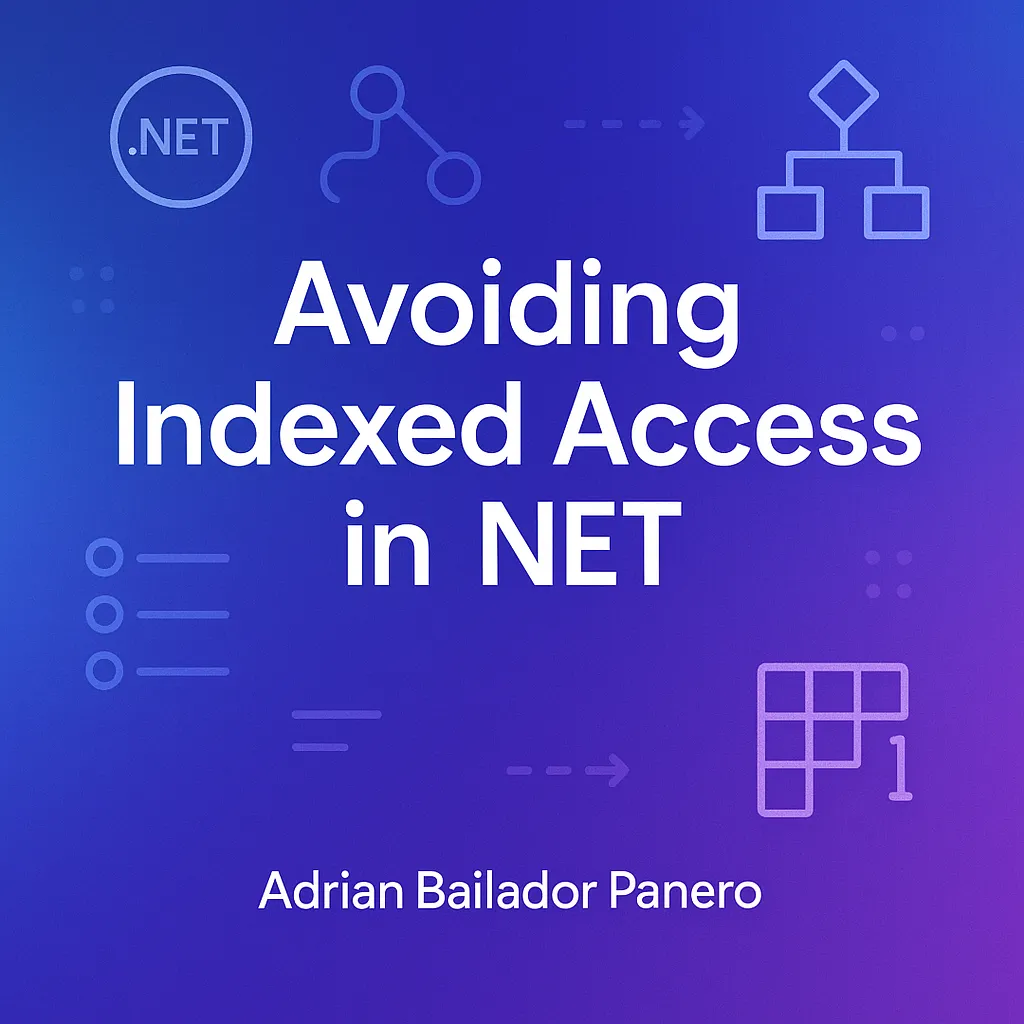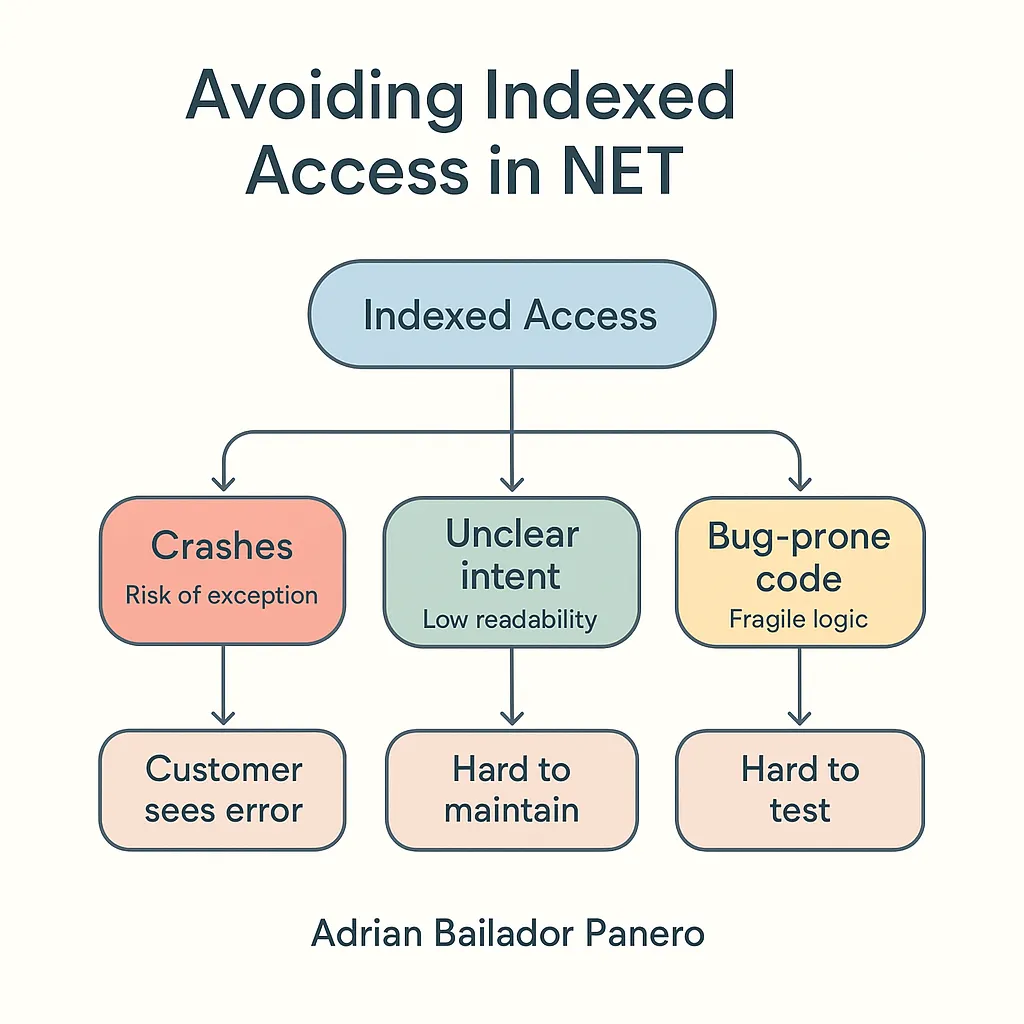
Accessing elements by index is a common pattern in .NET, especially when working with arrays or lists. However, when used carelessly in production code, it can lead to runtime exceptions, fragile logic, and poor readability. This article explores why avoiding direct indexed access can lead to safer and more maintainable .NET applications, and what alternatives you can use instead.
A Real-World Scenario
“Our dropdown list broke in production. Customers couldn’t select the default option, and support tickets flooded in. The reason? A developer accessed options[2], assuming the third item was always the default. It wasn’t anymore.”
Indexed access seems simple—until real data or UI changes prove it fragile.
Why Indexed Access Can Be Dangerous
1. Risk of Runtime Exceptions
Accessing elements without validating the index can result in IndexOutOfRangeException or ArgumentOutOfRangeException.
var items = new List<string>();
var first = items[0]; // Throws an exception if the list is empty2. Fragile Logic Based on Implicit Assumptions
When you use an index, you assume a fixed order or a guaranteed number of elements, which can easily change over time.
3. Poor Readability and Intent
An access like orders[3] doesn’t convey the purpose of that element. What is at index 3? Why 3?
Safer and More Expressive Alternatives
Use LINQ Methods
var customer = customers.FirstOrDefault(c => c.Id == targetId);This is safer and more expressive than using an index if the position is not guaranteed.
Use ElementAtOrDefault
var item = items.ElementAtOrDefault(2);This avoids exceptions and returns default(T) if the index is out of range.
Validate Index If Absolutely Necessary
if (items.Count > 2)
{
var safeItem = items[2];
}Still fragile, but safer than blind access.
Prefer foreach Over Indexed for
foreach (var item in items)
{
Process(item);
}This avoids issues with incorrect bounds and improves readability.
Encapsulate Indexed Logic
public Customer GetPreferredCustomer() => customers.FirstOrDefault(c => c.IsPreferred);Encapsulation makes your code more expressive and less error-prone.
When Indexed Access is Justified
There are valid cases where indexed access is efficient and appropriate:
- Performance-critical code (e.g., numerical algorithms, processing large datasets)
- Accessing arrays or spans in tight loops
- You’ve already validated the range
- Working with
Span<T>orMemory<T>where bounds are controlled
Example:
Span<byte> buffer = stackalloc byte[1024];
for (int i = 0; i < buffer.Length; i++)
{
buffer[i] = 0xFF;
}Benchmarks: Index vs Safer Alternatives
Using BenchmarkDotNet, we compared indexed access and LINQ methods. Benchmarks were executed using .NET 8 in Release mode on a Windows x64 environment.
[Benchmark]
public string Indexed() => items[3];
[Benchmark]
public string ElementAt() => items.ElementAt(3);
[Benchmark]
public string FirstOrDefault() => items.FirstOrDefault(x => x == "target");Results (simplified example)
items[3]: 0.5 nsElementAt(3): 5.1 nsFirstOrDefault: 15.3 ns
Conclusion: Direct access is faster—but in most business applications, safety and clarity outweigh nanosecond-level gains.
Real-World Example: Fragile UI Logic
// Bad: assumes fixed order in a dropdown
var selected = options[2];
// Better:
var selected = options.FirstOrDefault(o => o.IsDefault);Using index assumes options will never change order—a risky bet in production.
Visual Summary

Conclusion
Avoiding direct indexed access in .NET improves your code’s safety, readability, and maintainability. While it has its place in performance-critical or algorithm-heavy code, most business applications benefit more from expressive and validated alternatives.